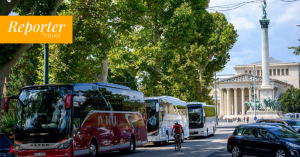Hungarian Federation of National Private Transporters would obtain a capital injection for Hungarian tourism companies, which were destroyed by the end of 2020
BUDAPEST, HUNGARY, June 11, 2021 /EINPresswire.com/ -- Hungary’s government responded to the covid-19 pandemic by simultaneously fearing the worst and assuming the best. The tactics may have been deadlier than the virus: 80% of domestic passenger transportation companies went bankrupt. However the Hungarian government intends to continue to take advantage of the "golden age" that tourism has experienced in recent years and aims to increase it from 10% to 16% of the country’s GDP by 2022.
Federation of National Private Transporters would obtain a capital injection for Hungarian tourism companies, which were destroyed by the end of 2020, through group domestic trips, for which it calls on the government's strategic partners to cooperate responsibly. They submitted a package of proposals to the Hungarian Tourism Agency provides employment and income opportunities in those sectors of tourism whose activities have ceased as a result of the epidemic or their performance has fallen drastically - reports Travel Reporter
2020 compared to 2019
• Commercial accommodation registered 58% less, for a total of 13 million guest nights.
• Domestic guests spent 39 and foreigners 77% less (9.6 million and 3.7 million, respectively) guest nights in commercial accommodation.
• Total gross sales revenue of commercial accommodation establishments decreased by 59% at current prices and amounted to HUF 228 billion.
• In December, total gross sales of commercial accommodation were 93% lower than in December of the previous year, indicating that for a very large number of accommodation, revenues fell to zero.
pre-COVID growth in Hungary
In Hungary, tourism contributes to economic stimulation and job creation at a rate somewhat above the global average.
Before the pandemic, tourism has grown into one of Hungary’s major economic sectors, which plays an important role in both GDP production and in employment, as well as in maintaining the balance of payments. Our tourism indicators have been continuously improving since 2010, and 2019 also saw an expansion.
Tourism output has been setting records in Hungary every year since 2010, and in 2019 Hungary closed the best tourism year ever with 12 920 arrivals and 31 538 guest nights.
626,000 visitors from Germany contributed more than 2 million guest nights to the tourism turnover recorded in Hungary, despite the continued downturn in German visitor numbers. At the same time, with the exception of Germany and Austria, Hungary experienced an increase in guest nights in terms of all ten of its main feeder markets in 2019.
The largest increase was observed for guest nights from Israel (+10.3%), Romania (+8.3%) and the United Kingdom (+4.9%), yet the expansion in visitor numbers is also visible in the case of guests from the Czech Republic (+3.5 %), Russia (+3.5%), the United States (+3.0%), Poland (+2.7%) and Italy (+0.1%).
In Domestic Tourism there was an inflow of HUF 190.6 billion to tourism and hospitality enterprises in 2019.
Corporate responsibility could save the transportation sector in Hungary
As tourism moves individuals across time and space, the tourism sector is relying on mobility systems. The development of international tourism goes in parallel with the democratisation of the transport sector.
The “Sectoral Solidarity” program invites groups of 25-50 people made up of family members and employees of multinational companies to a complex one- or more-day domestic program.
These trips are usually based on sightseeing, thematic, cultural, gastro-tourism, and leisure and adventure tourism-related programs.
Referring to the Growth Plan, the Hungarian government has entered into strategic partnership agreements with 88 large Hungarian companies and domestic subsidiaries of multinational companies since 2012. These strategic partners are Hungary's largest employers, companies that, according to their sectoral classification, range from the energy sector, to pharmaceutical companies, to commercial and financial and banking companies.
The aim is for strategic companies to register for any of the travel packages announced in the program and to participate in these thematic events to the extent possible in accordance with their opportunities and role.
Thus, the program can help the victims of the tourism sector primarily in the fields of travel organization, travel mediation, bus trips, and guided tours.
The inventors expect the program primarily to generate traffic in those sectors of tourism that are less clearly starting out on their own, such as the areas mentioned above. But accommodation, restaurants and cultural tourism businesses can also expect additional revenue.
Mobility - the key of tourism
Mobility is a key enabler of tourism and plays a vital role in moving tourists from their place of residence to their final destination and on to various attractions. Transport connects the markets in tourism generating regions to destinations and facilitates the internal movement of visitors between components of the tourist experience (e.g. attractions, accommodation, commercial services, etc.), and can be a major element of the attraction or an experience in their own right.
The location, capacity, efficiency and connectivity of transport can therefore play an important role in how a destination physically develops, and significantly influence the mobility of visitors and the connectivity of tourist experiences within destinations.
This includes the journey from a tourist’s place of residence until their arrival at their final or primary destination, and then on to supporting attractions in the area.
The different segments are often referred to as the first- and last-miles of the journey.
Transport policy is therefore closely aligned with economic development policies (including tourism), given that an efficient, competitive and sustainable transport system is a prerequisite for the movement of goods and/or people, and ultimately the efficient and competitive functioning of the economy.
Local transportation is a victim of COVID in Hungary
Federation of National Private Transporters (NiT Hungary) started a wide-ranging consultation on the program with the interest groups of the tourism sector and government actors.
„NiT Hungary wants to help in this situation with the “Sector Solidarity” program and to provide a lifbuoy for the tourism sector.” – said Gábor Dittel, secretary of NiT Hungary. „The Federation is working on cooperations with domestic and international partners such as the Hungarian organizers of the International Eucharistic Congress and the UEFA organizer Hungarian Football Association.” – he added.
Witty Sharp
Travel Reporter
hq@travel-reporter.com






